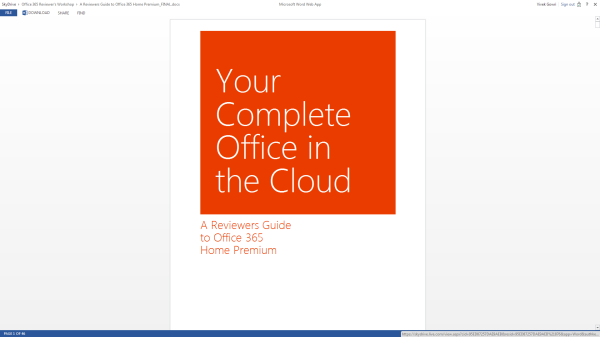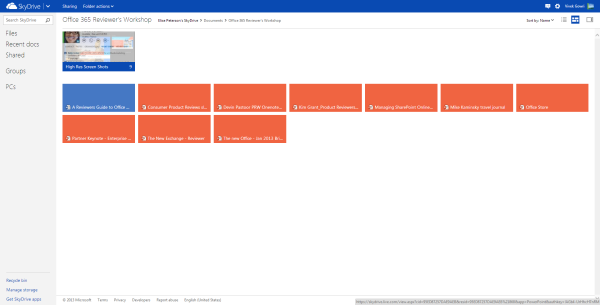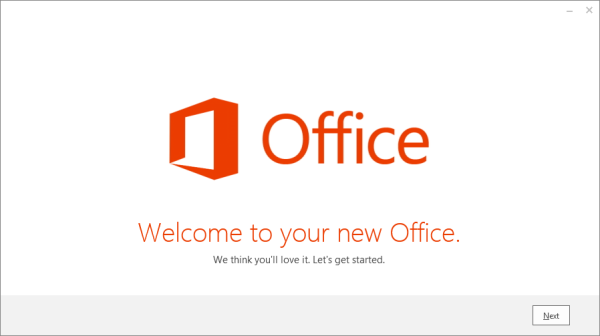Three Months with Microsoft's Office 365
by Vivek Gowri on January 31, 2013 11:59 PM EST- Posted in
- Microsoft
- Cloud Computing
- Office 2013
- SkyDrive
How big is Microsoft pushing the cloud integration in Office 2013? After signing into a Microsoft account, SkyDrive is the default save location in all Office apps, replacing the local My Documents folder. That’s an important distinction, because SkyDrive is a huge part of the Office 365 message (and likewise, Office integration is a huge part of SkyDrive’s appeal).
Combined with Office Web Apps in SkyDrive, the Office+SkyDrive combination is actually a pretty powerful way of creating and editing documents and presentations from the web, much more so than Google Docs is. And in that, I think Office 365 makes some huge strides in matching the convenience factor of Google’s purely online document creation tools, except with all the versatility and formatting power that comes with proper Office.
Sharing files from SkyDrive is also a breeze, much like Dropbox. And honestly, between the cheaper storage upgrades and Office integration, SkyDrive looks like a pretty compelling option for cloud storage when compared to Dropbox. Microsoft is doing a good job of leveraging its own products and services for better online integration, and that’s really one of the main stories in the new Office.
I’m coming away from Office 365 a big fan of the Office 2013 suite, along with a newfound appreciation of SkyDrive. The combination is a potent one, and could make the lives of students and professionals much, much easier. Unlike many Microsoft software redesigns of years past, including Windows 8, I don’t have too much in the way of misgivings about this one. The improvements are pretty comprehensive, and offer a more streamlined, polished, and visually refined user experience. That’s about all you can ask from an office suite.
My real questions center primarily around the subscription model. And even that is mostly limited to single or dual user families that don’t have access to a University subscription or Microsoft’s historically lenient home use agreements for commercial licenses. The $99 yearly price for Office 365 is pretty steep if you don’t make use of either the multi-computer install capabilities or the cloud services. I’d say in that case, you’re probably better off just getting a standalone Office 2013 license and signing up for a SkyDrive account which comes with 7GB of free storage. If you really need more storage, the 20GB upgrade only costs $10 per year, which isn’t bad at all. Or, alternatively, you could pay a student to get you an Office 365 University serial number on the cheap. [Update: I was joking about this part, sorry if it didn't come across that way. Yes, it violates the EULA, so no, don't do this.]
Other than that? It’s great. If you’ve got 4 or 5 computers to install Office on, $99/year isn’t bad at all, and for students that can get the University license, $79 for 4 years is a bargain considering that it comes with 20GB of SkyDrive storage for that four year stretch of time. If you have Office 2010 and are happy with it, I wouldn’t say you need to upgrade though the cloud integration makes that a compelling option, but for users of any previous edition Office, I’d seriously recommend making the transition.













113 Comments
View All Comments
Guspaz - Friday, February 1, 2013 - link
Office was launched in November of 1990, which gives us a maximum age for Vivek of 22 years :)tipoo - Friday, February 1, 2013 - link
22 and done a masters? It's possible I guess, but not common.WeaselITB - Friday, February 1, 2013 - link
Yeah, I was going to say:Wow, Office and Windows were before he was born? I feel old. :-/
VivekGowri - Saturday, February 2, 2013 - link
I'm 21 :)FunBunny2 - Friday, February 1, 2013 - link
Well, depends on how you measure. "Office" isn't a program, and never was, it's just the name for a bundle of GUI programs: Word, Excel, PPT, etc. The first GUI program in the bundle was Word for Mac (paid for by Apple, by the way), in 1985. That's nearly 30 years.philosofool - Friday, February 1, 2013 - link
Can I buy two university licenses and then use it on 4 devices? Also, what happens when I replace a licensed device? 4 years is longer than the typical student's laptop lasts.HardwareDufus - Friday, February 1, 2013 - link
Is their a different file structure for Office 2013 vs 2010 documents?For instance, there was little change between Office 2007 structures and 2010.
Subyman - Friday, February 1, 2013 - link
I believe it is somewhat strange that the author keeps discussing breaking MS's EULA by recommending users consider getting a student to purchase a license for non-educational use.Lazlo Panaflex - Friday, February 1, 2013 - link
"I’ve always been a fan of the ribbons, which I thought were a good idea in Office 2007 but really came into their own with Office 2010. It’s been six years since they debuted, so anyone that is still complaining about Ribbon UI should really get over it"Really? Maybe your Microsoft fanboi-ish comments belong in a blog, not a front page article.
colonelpepper - Friday, February 1, 2013 - link
agreed.. totally unprofessionaltotally reading like it was written by microsoft